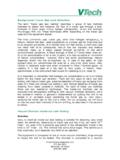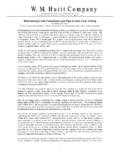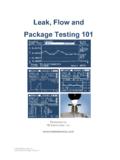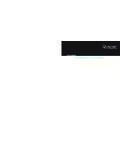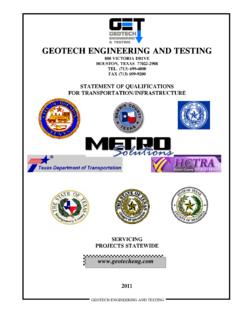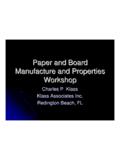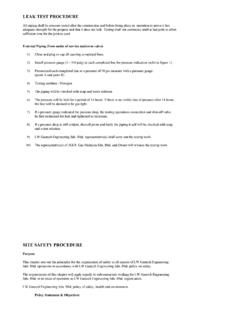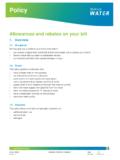Transcription of How to Establish an Acceptable Leak Rate - Leak …
1 Application Bulletin: #120 Date: Oct 2014 How to Establish an Acceptable Leak Rate Purpose: This Application Bulletin is to provide an overview of how to Establish an Acceptable leak rate. Purpose of leak testing Parts Confirm manufacturing process is performing to specification and making good parts Find defective product earlier in manufacturing process so that corrective action can be taken to get production process in control before additional costs are added. Reduce total manufacturing cost. Assure product will perform function for which it is designed. Reduce or eliminate warranty problems. Improve customer satisfaction with product. Comply with environmental concerns. What Defines that the Part s Leak Integrity is Acceptable for its Function? The part does not leak an unacceptable amount of fluid (water, water vapor, oil, fuel, blood, medicine, etc.)
2 That it is designed to contain under operating or static conditions. Can a Part Leak other Fl uids or Gases like Air and still NOT Leak the Fluid for which the Part was Intended to Contain? YES What are the Characteristics of a Hole (Leak) and the Contained Fluid that Make It Difficult or Near Impossible for a Fluid to Leak Out. If the defect (hole) in the part is small enough or the path length for the leak is long enough, it will be almost impossible for the fluids to flow through the hole (leak). The fluid properties that affect flow are pressure, temperature, and viscosity. Pressure - Greater pressure behind a hole may cause fluid to flow faster or at a greater flow rate. 20 psi 40 psi Application Bulletin: #120 Page 2 Temperature - For liquids, higher temperatures change the characteristics of the fluid so that it flows easier and therefore faster. For gases, higher temperatures change the characteristics of the gas so that it flows slower.
3 The examples listed below under viscosity show how temperature causes the resistance-to-flow characteristic of the fluid to decrease for liquids and increase for gases. Viscosity - Viscosity is the measurement of the internal fluid resistance of a substance. It quantifies the fluid s resistance to flow. Higher viscosities indicate a greater resistance to flow. Low viscosities indicate less resistance to flow or a higher probability of leaking or flowing at a higher rate. Examples of typical fluid viscosities at room temperature (70oF) and at 200 degrees F are: Fluid 70oF 200 oF SAE10 lube 65 centipoise 5 centipoise Fuel oil #5 (min) 8 centipoise 2 centipoise Water centipoise centipoise Gasoline centipoise centipoise Propane (liquid) centipoise centipoise Air centipoise centipoise Helium centipoise Propane (gas) centipoise centipoise One can imagine that heavy oil or grease will not flow very easily or at all through a small hole where water might flow.
4 The concept of using grease or oil film to seal two mating parts relies on this fact. The ratio of the viscosities between SAE10 lube and water at 70oF is roughly 68:1. In other words water will flow approximately 68 times more units of volume through a hole than SAE10 lube if the lube is able to flow at all. By the same principle when subjected to very low pressure (<1 psig), air will flow approximately 53 times more units of volume through a hole than water if the water is able to flow at all. The characteristics of the hole (or leak) that determine whether it will leak are the smallest diameter in the hole path, the path length of the hole through the part material, surface tension, and the surface finish of hole (leak). Hole Size - The smallest opening in the flow (leak) path controls the rate of flow through the path. The small opening tends to dam up the flow path. Smallest opening Application Bulletin: #120 Page 3 Path Length - The length of the flow path through which a fluid must pass will control how much fluid will flow because long path lengths add resistance to flow.
5 For Laminar Liquid Flow, the generalized equation that relates flow rate (QL) in ccm to the hole diameter (d) in inches, path length (L) in inches, fluid viscosity (uL) in centipoise, and pressure across the part wall (dPL) in psi is the following: (d inch)4 PL (psi) Liquid Flow: QL (ccm) = x 108 x ------------ x -------------------- L (inch) uL (centipoise) Note: x 108 (used above) is the resistance coefficient constant for liquids. Ex: Under Ideal Conditions what is the flow rate of water through a leak ( inches diameter) with a path length of 1/16 inch under pressure of 100 psi at 70oF ignoring surface tension and evaporation? ( )4 100 QL = x 108 x -------------- x ------- QL = x 108 x x 10-13 x QL = 715 x 10-5 ccm = ccm (This is approximately 1 drop of water with a diameter of 1/8 in minutes.)
6 For Laminar Gas Flow, the generalized equation that relates flow rate to the hole diameter (d), path length (L), gas viscosity (ug), pressure across the part wall (dPg), and average absolute pressure across the leak path (Pa) in psi is the following: (d inch)4 dPg (psig) Gas Flow: Qg (sccm) = x 107 x ------------- x --------------------- x Pa (psi) (L inch) ug (centipoise) Note: x 107 (used above) is the resistance coefficient constant for gasses. What air flow will occur through a inch diameter leak with a 1/16 inch path length if the part were pressurized with 100 psi air at 70oF? (4 x 10-4)4 100 (100 + ) Qg = x 107 x ------------- x ---------- x ----------------- 2 Qg = x 107 x x 10-13 x x 103 x Qg = sccm (This is equivalent to 100 bubbles with a diameter of 1/8 in one minute in a dunk tank) Application Bulletin: #120 Page 4 From the formulas it indicates that as the hole size gets smaller, it reduces the flow by a factor to the fourth power.
7 As the path length gets longer it has an inverse proportional effect to reduce the flow. When comparing liquid and air flow rates, the flow rate increases due to the reduced viscosity and the expansion characteristics of the gas. The following formula which is derived from the two formulas above reflects a comparison of liquid flow to gas flow across a common leak. Qg uL dPg ----- = Pa x ----- x ------ QL ug dPL This formula reflects the theoretical relationship on flow of changing test pressures between liquid and air applications and the proportional effect of going from a liquid viscosity test media to a gas viscosity test media. Qg 100 + 100 ----- = x ---------------- x ---------- x ------ QL 2 100 Qg ----- = x x x 1 = 205 QL Surface Tension of Liquid Flow into Air - In order for a liquid to flow out of a small capillary hole, the pressure of the liquid must be greater than the surface tension pressure.
8 The relationship of surface tension pressure (P) psi to leak (or hole) diameter (d) in inches and the surface tension of specific liquid (a) in lb/in. is: 4 a P = ------ Pressure required to overcome surface tension d increases as the leak diameter (d) gets smaller. If the diameter gets small enough the surface tension will prevent liquid flow. Ex. Water has a surface tension of .00497 lb/ft ( lb/in). What internal pressure would be required to overcome the surface tension on a part with a capillary hole with an approximate diameter of inches? 4 x lb/in. P = -------------------------- = psi in. Application Bulletin: #120 Page 5 Ex: If a 10 tall container holds water, what is the size of the hole at the bottom of the container where the water head pressure in the container equals the surface tension pressure of water to air.
9 This is the critical dimension where the contained water pressure will overcome the surface tension and shows a visible leak. 4 x surface tension 4 x lb/in Diameter = -------------------------- = ------------------------- Pressure (10 ) psi Diameter < inches there will be no visible leak. Leak Path Surface Finish - The conditions of the walls inside a leak path also effect the flow rate and resistance to flow. Smooth walls will resist flow less than more typical rough walls. The leak standards produced by Cincinnati Test Systems for calibrated flow rates feature smooth walls which provide maximum flow with optimal repeatability for calibration. Typical holes or leaks are not designed and usually are rough and irregular. Therefore, it is difficult to get repeatable flow through these types of holes. The rough surface finish of typical holes will increase the surface area and therefore the adhesive characteristics of the hole.
10 This in conjunction with the viscosity of typical contained fluids will prevent or severely restrict the fluids from flowing while lower viscosity air will still flow. Setting a Leak Rate Standard The first principle that must be understood is that all materials permit some leakage through them over a period of time. It may leak as little as a few molecules of hydrogen a year to several gallons of fluid per minute. The purpose of establishing a leak rate specification is to define the maximum tolerable leakage that a properly functioning part can tolerate and still meet the customer s expectation. The objective is to test the parts with air or some other low cost, safe fluid whose viscosity is lower than the specified contained fluid and will therefore qualify the holes faster, easier, and more economically. Although the desire is to manufacture a part that doesn t leak the specified fluid, a specification of No Leak does not Establish a tolerance for testing the parts and determining their functionality.



